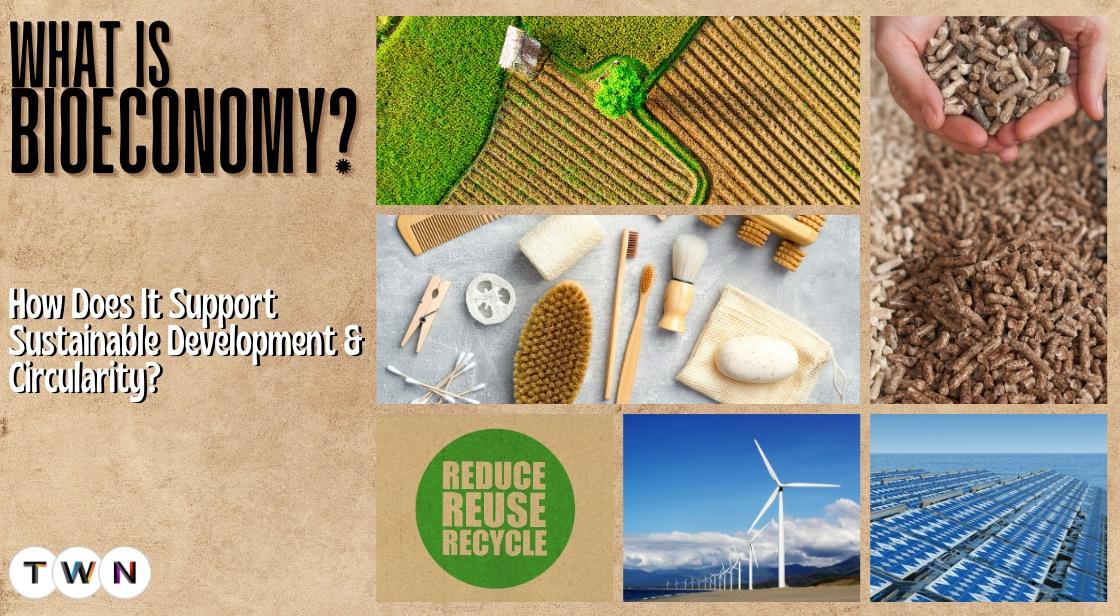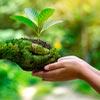What is Bioeconomy and How Does It Support Sustainable Development and Circularity

Blog Post
In an era where sustainability and circularity are paramount, the bioeconomy has emerged as a promising solution. But what exactly is the bioeconomy, and how does it contribute to sustainable development and circular practices?
The bioeconomy, a rapidly expanding sector, holds the key to transforming the way we produce, consume, and manage biological resources.
It offers a unique opportunity to drive sustainability and circularity by replacing fossil fuel-based products and processes with renewable and sustainable bio-based alternatives.
In this blog post, we'll delve into the concept of the bioeconomy, its key components, policies, and how it supports sustainable development and circularity.
We'll explore how bioeconomy products are already making their mark in various industries, the benefits they offer, the challenges they face, and what the future holds for this dynamic and transformative sector.
The bioeconomy is not just a buzzword but a tangible force that promises a greener, more sustainable, and economically vibrant future.
The bioeconomy is a dynamic and growing sector that is transforming the way we produce, consume, and manage biological resources. It offers a unique opportunity to drive sustainable development and circularity by replacing fossil fuel-based products and processes with renewable and sustainable bio-based alternatives.
The bioeconomy is a knowledge-based economy that relies on the sustainable production and use of renewable biological resources to provide products and services. It encompasses a wide range of sectors, including agriculture, forestry, fisheries, aquaculture, and biotechnology.
The bioeconomy is playing an increasingly important role in supporting sustainable development and circularity. By replacing fossil fuel-based products and processes with renewable and sustainable bio-based alternatives, the bioeconomy can help us to reduce greenhouse gas emissions, conserve natural resources, and create new jobs and economic opportunities.
What is bioeconomy ?
The concept of the bioeconomy, as articulated by the United Nations Food and Agriculture Organisation (FAO), encapsulates a multifaceted approach.
It's a holistic strategy that encompasses the sustainable production, utilization, and conservation of biological resources, and it involves a comprehensive knowledge base, scientific advancements, technological innovations, and an overarching aim to offer a broad spectrum of information, products, processes, and services across all economic sectors.
In essence, it's a concerted effort directed at the evolution of a more sustainable economy that operates in harmony with the natural world.
The term "bioeconomy" gained prominence in the early 21st century when it was officially embraced by two influential organizations: the European Union (EU) and the Organisation for Economic Co-operation and Development (OECD).
These organizations recognized it as an indispensable framework to harness the potential of biotechnology in the development of new products and markets, all while adhering to principles of sustainability and resource conservation.
Key Components of the Bioeconomy:
-
Biological Resources: At the heart of the bioeconomy are biological resources, which encompass a wide array of elements such as plants, animals, micro-organisms, and biomass derived from organic sources. These resources serve as the foundation for the bio-based innovations that the bioeconomy champions.
-
Sustainability: A fundamental pillar of the bioeconomy is the commitment to sustainability. It seeks to balance human needs with environmental preservation, steering clear of the overexploitation of natural resources and striving to enhance biodiversity. By doing so, the bioeconomy aligns with global environmental goals and contributes to the overall well-being of the planet.
Principles of bioeconomy:
-
Sustainability: The bioeconomy must be based on the sustainable production and use of biological resources. This means that we must use biological resources in a way that does not compromise the ability of future generations to meet their own needs.
-
Circularity: The bioeconomy should be circular, meaning that we should minimize waste and maximize the value of biological resources at all stages of their life cycle.
-
Innovation: The bioeconomy is driven by innovation. New technologies and processes are constantly being developed to improve the efficiency and sustainability of bio-based production and consumption.
Also Read: Top Organic Food Companies in the World
Bioeconomy Policies:
The European Union (EU) and the Organisation for Economic Co-operation and Development (OECD) have both developed comprehensive bioeconomy policies that aim to promote the sustainable use of biological resources to create economic and social benefits.
European Union Bioeconomy Strategy
The European Union's Bioeconomy Strategy was officially adopted in 2012 and subsequently revised in 2018. The strategy sets out a vision for a sustainable and competitive bioeconomy in Europe, with the following key objectives:
- To sustainably mobilize biological resources and convert them into value-added products, processes and services.
- To develop and deploy key enabling technologies for the bioeconomy.
- To strengthen markets for bio-based products and services.
- To create the conditions for consumers and businesses to make informed choices about bio-based products and services.
- To ensure that the bioeconomy is developed and deployed in a sustainable and inclusive way.
The EU's Bioeconomy Strategy is supported by a number of specific policy initiatives, including:
- The Common Agricultural Policy (CAP), which provides funding for farmers and rural communities to support the production of sustainable biomass.
- The Horizon 2020 research and innovation programme, which has invested over €1 billion in bioeconomy research projects.
- The Bio-Based Industries Joint Undertaking (BBI JU), a public-private partnership that supports the development and commercialization of bio-based products and processes.
- The Circular Economy Action Plan, which sets out a vision for a more circular economy in Europe, where biological resources are used more efficiently and recycled and reused whenever possible.
OECD Bioeconomy Policy Framework
The OECD Bioeconomy Policy Framework was adopted in 2010. The framework provides a set of principles and guidelines for governments to develop and implement bioeconomy policies.The framework concentrates on the subsequent critical domains:
- Mobilizing biological resources in a sustainable way.
- Developing and deploying enabling technologies.
- Creating markets for bio-based products and services.
- Ensuring that the bioeconomy is developed and deployed in an inclusive and sustainable way.
The OECD Bioeconomy Policy Framework is supported by a number of specific policy initiatives, including:
- The OECD Bioeconomy Observatory, which provides a platform for governments to share information and best practices on bioeconomy policy.
- The OECD Bioeconomy Policy Review, which provides an independent assessment of bioeconomy policy developments in OECD countries.
- The OECD Bioeconomy Policy Forum, which brings together stakeholders from government, industry, academia, and civil society to discuss bioeconomy policy issues.
How the bioeconomy supports sustainable development and circularity ?
The bioeconomy supports sustainable development and circularity in a number of ways, including:
Reducing greenhouse gas emissions
The bioeconomy can help to reduce greenhouse gas emissions in a number of ways, including:
-
Biofuels: Biofuels can be used to replace fossil fuels in transportation, which can help to reduce greenhouse gas emissions from the transportation sector. For example, ethanol can be blended with gasoline to reduce greenhouse gas emissions from vehicles.
-
Bio-based plastics: Bio-based plastics can be used to replace petroleum-based plastics, which can help to reduce greenhouse gas emissions from the plastics industry. For example, polylactic acid (PLA) is a bio-based plastic that can be used to make a variety of products, including packaging and disposable utensils.
-
Bioenergy: Bioenergy can be used to generate electricity and heat, which can help to reduce greenhouse gas emissions from the energy sector. For example, biomass can be used to generate electricity in power plants, and biofuels can be used to generate electricity and heat in homes and businesses.
Conserving natural resources
The bioeconomy can help to conserve natural resources in a number of ways, including:
-
Renewable resources: The bioeconomy uses renewable biological resources, such as biomass, to produce products and processes. This can help to conserve non-renewable resources, such as fossil fuels and minerals.
-
Sustainable production methods: The bioeconomy uses sustainable production methods to produce products and processes. This can help to reduce the environmental impact of the bioeconomy. For example, many bio-based products are produced using sustainable agricultural practices, such as crop rotation and cover cropping.
Creating new jobs and economic opportunities
The bioeconomy is a growing sector that is creating new jobs and economic opportunities around the world. For example, the global bioeconomy market is expected to reach $4 trillion by 2025.
Here are some examples of the latest developments in the bioeconomy:
-
Biofuels: New technologies are being developed to make biofuels more efficient and cost-competitive. For example, researchers are developing new ways to convert biomass to biofuels using enzymes and other catalysts.
-
Bio-based plastics: New bio-based plastics are being developed with improved properties, such as durability and heat resistance. For example, polyhydroxyalkanoates (PHAs) are a class of bio-based plastics that are known for their durability and biodegradability.
-
Bioenergy: New bioenergy technologies are being developed to improve the efficiency and cost of bioenergy production. For example, researchers are developing new ways to convert biomass to bioenergy using thermochemical conversion processes.
The bioeconomy is a growing sector that is creating new jobs and economic opportunities around the world. According to a report by the Food and Agriculture Organization of the United Nations (FAO), the bioeconomy could create up to 20 million new jobs globally by 2030.
The bioeconomy encompasses a wide range of industries, including agriculture, forestry, fisheries, food and beverage processing, bioenergy, biofuels, biomaterials, and biopharmaceuticals. Each of these industries is growing and creating new jobs.
For example, the global biofuels market is expected to reach $367 billion by 2028. The growth of this market is creating new jobs in the production and distribution of biofuels.
The global bioplastics market is also expected to grow significantly in the coming years. This market is expected to reach $11.8 billion by 2027. The growth of this market is creating new jobs in the production and use of bioplastics.
The bioeconomy is also creating new jobs in the research and development of new bio-based products and processes. For example, the US Department of Energy (DOE) is investing heavily in research and development on biofuels and bioenergy. The DOE's Bioenergy Technologies Office (BETO) is funding a number of projects that are developing new technologies to produce biofuels and bioenergy from biomass.
Also Read : What is Environmental Impact Assessment and why It Matters?
Latest information on job creation in the bioeconomy
-
A recent study by the World Economic Forum found that the bioeconomy is expected to create up to 1.5 million new jobs in the United States by 2030.
-
The European Commission estimates that the bioeconomy could create up to 2 million new jobs in the European Union by 2025.
-
The Government of Canada has invested $190 million in the bioeconomy over the past five years. This investment is supporting the development of new bio-based products and processes, and the creation of new jobs in the bioeconomy.
Examples of the bioeconomy in action:
There are many examples of the bioeconomy in action today. Here are a few examples:
-
Biofuels: Biofuels, such as ethanol and biodiesel, are produced from renewable biological resources, such as corn, soybeans, and sugarcane. Biofuels can be used to reduce our reliance on fossil fuels for transportation and help to reduce greenhouse gas emissions.
-
Bio-based plastics: Bio-based plastics are produced from renewable biological resources, such as corn starch and sugarcane. Bio-based plastics can be used to produce a wide range of products, from packaging to textiles. Bio-based plastics can help to reduce our reliance on petroleum-based plastics and reduce greenhouse gas emissions.
-
Bio-based chemicals: Bio-based chemicals are produced from renewable biological resources, such as corn starch and sugarcane. Bio-based chemicals can be used to produce a wide range of products, from cleaning products to pharmaceuticals. Bio-based chemicals can help to reduce our reliance on petroleum-based chemicals and reduce greenhouse gas emissions.
What are Bioeconomy products ?
The bioeconomy is a rapidly growing sector that is transforming the way we produce and consume goods and services. Bioeconomy products are those that are wholly or partly derived from biomass, such as plants, trees, and animals. They can be used to replace or improve fossil-based products, or to create entirely new solutions.
Bioeconomy products are already being used in a wide range of industries, including:
-
Chemicals: Biobased chemicals can be used to produce a wide range of products, from plastics to pharmaceuticals. For example, biobased ethanol can be used to produce bioplastics, and biobased succinic acid can be used to produce food additives and cosmetics.
-
Materials: Biobased materials can be used to produce a wide range of products, from packaging to furniture. For example, biobased plastics can be used to produce compostable food packaging, and biobased textiles can be used to produce sustainable clothing.
-
Energy: Bioenergy can be used to produce heat, electricity, and transportation fuels. For example, biofuels can be used to power cars and trucks, and biogas can be used to generate electricity and heat.
-
Food and beverages: Biobased food and beverages can be made from a variety of plant-based ingredients. For example, plant-based milks and cheeses are becoming increasingly popular, and biobased plastics can be used to package food products.
Benefits of bioeconomy products
Bioeconomy products offer a number of benefits over fossil-based products, including:
-
Sustainability: Bioeconomy products are produced from renewable resources, which helps to reduce our reliance on fossil fuels and mitigate climate change.
-
Circularity: Bioeconomy products can be more easily recycled and composted than fossil-based products, which helps to reduce waste and pollution.
-
Health and safety: Bioeconomy products can be made from safer and more sustainable ingredients than fossil-based products. For example, biobased plastics are often made from plant starch instead of petroleum, which makes them less toxic and easier to biodegrade.
Challenges of bioeconomy products
Despite the many benefits of bioeconomy products, there are also some challenges that need to be addressed, such as:
-
Price: Bioeconomy products are often more expensive than fossil-based products, which can make them less competitive in the marketplace.
-
Availability: The supply of biobased feedstocks is not always guaranteed, which can make it difficult to produce bioeconomy products on a large scale.
-
Technology: Some bioeconomy technologies are still in their early stages of development, which means that they can be less efficient and more costly than fossil-based technologies.
The future of bioeconomy products
Despite the challenges, the future of bioeconomy products is bright. As the demand for sustainable products continues to grow, bioeconomy companies are investing in new technologies and developing new products that meet the needs of consumers and businesses.
Here are some specific examples of bioeconomy products that are already being used today:
-
Biobased plastics: Biobased plastics are made from plant-based materials, such as corn starch and sugarcane. They are used in a variety of products, including food packaging, toys, and medical devices.
-
Biobased textiles: Biobased textiles are made from plant-based fibers, such as bamboo and hemp. They are used in a variety of products, including clothing, bedding, and carpets.
-
Biobased fuels: Biobased fuels are made from plant-based materials, such as corn ethanol and soybean biodiesel. They are used in cars, trucks, and buses.
-
Biobased chemicals: Biobased chemicals are made from plant-based materials, such as bioethanol and biosuccinic acid. They are used in a variety of products, including plastics, pharmaceuticals, and food additives.
The bioeconomy is a rapidly growing sector with the potential to revolutionize the way we produce and consume goods and services. Bioeconomy products offer a number of benefits over fossil-based products, and they are becoming increasingly affordable and available. As the demand for sustainable products continues to grow, the bioeconomy is poised to play a major role in the future of the global economy.
Conclusion:
The bioeconomy is a dynamic and growing sector that offers a unique opportunity to drive sustainable development and circularity. By replacing fossil fuel-based products and processes with renewable and sustainable bio-based alternatives, the bioeconomy can help us to reduce greenhouse gas emissions, conserve natural resources, and create new jobs and economic opportunities.
You May Like
EDITOR’S CHOICE












